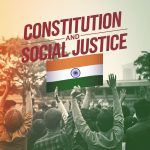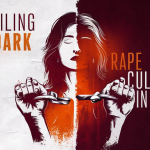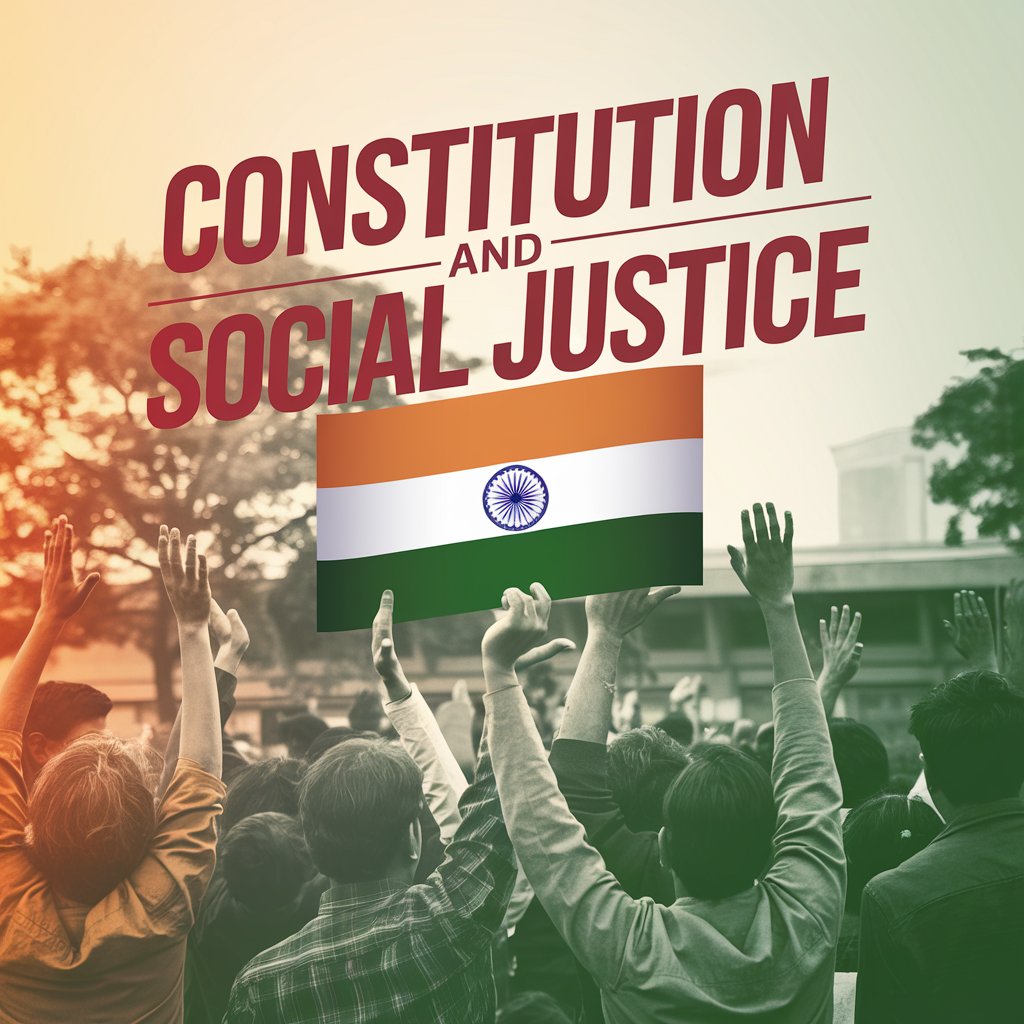Constitution and Social Justice
Introduction
The relationship between the constitution and social justice is crucial in understanding howmodern states aim to balance individual rights with collective equality. In sociology, social justice refers to the fair distribution of resources, opportunities, and privileges within a society. A constitution, as the foundational legal document of a country, often lays out the frameworkfor ensuring such justice. The Indian Constitution, one of the most comprehensive in theworld, is designed to address deep-rooted social inequalities and establish a just and fair society. Thisassignment will explore the concepts of constitution and social justice, their interrelation, and how they manifest in the Indian context.
Starting With The Understanding Of Concept Justice
Justice, in its broadest sense, refers to the principle of fairness, equity, and moral
righteousnessn social interactions, institutions, and governance. It entails the fair and impartial
treatment of individuals and groups, ensuring that everyone receives what they are
due—whether in terms of rights, resources, opportunities, or responsibilities. Justice servesasthe foundation for legal and social systems, aiming to rectify wrongs, protect rights, andmaintain social order. There are various forms of justice that address different aspects of fairness:
- Distributive Justice:-This concerns the fair allocation of resources, wealth, and opportunitieswithin a society. The question it seeks to answer is how society’s goods should be distributedamong individuals and groups, particularly with respect to social and economic equality. Distributive justice is central to debates about welfare, taxation, and public policy.
- Procedural Justice:-This type of justice focuses on the fairness of the processes by whichdecisions are made. It concerns how laws are applied and how legal and institutional
procedures are conducted. Procedural justice is about ensuring transparency, fairness, andimpartiality in legal processes, making sure all individuals receive equal treatment under thelaw. - Retributive Justice:-Retributive justice deals with punishment for wrongdoings. It emphasizesthat individuals who commit crimes or wrongs should face consequences that are proportionate to the offense. This form of justice often manifests in criminal justice systems, where laws are enforced through penalties such as fines, imprisonment, or other forms of
punishment. - . Social Justice:-Social justice refers to the idea of creating a society where all individualshaveequal rights, opportunities, and access to resources. It emphasizes the removal of social, economic, and political inequalities. In a broader context, social justice seeks to address systemic discrimination and ensure that marginalized groups are given fair treatment. It isconcerned with the distribution of wealth, privileges, and power in society, aiming to createequity for all individuals.
Understanding the Concept of Social Justice
Social justice means providing justice to all those people who have had to face injustice havingbeen subject to some form of dominance. They may have had to face injustice due to their Verna, ethnicity, profession, gender, economic status, region, religion, tradition, languageor physique. Social justice, basically, is an incessant battle against privileges-based meritocracy. Humanism and compassion are the cornerstones of this battle. The idea of securing anequal opportunity for all and the theory of social diversity are its sword and rifle.
A distinctive concept of ‘social justice’, as opposed to the more ancient ideal of ‘justice’, first emerged in the early nineteenth century. Social justice refers to a morally defensible distributionof benefits or rewards in society, evaluated in terms of wages, profits, housing, medical care, welfare benefits and so forth. Social justice is therefore about ‘who should get what’. For example, when, if ever, do income differentials become so wide they can be condemnedas‘unjust’? Or, on an international level, are there grounds for arguing that the unequal distributionof wealth between the developed North and the developing South is ‘immoral’? In the view of some commentators, however, the very notion of social justice is mistaken. They argue that thedistribution of material benefits has nothing whatsoever to do with moral principles like justice, but can only be evaluated in the light of economic criteria,such as efficiency and growth. Hayek’s antipathy towards the term can, for example, be explained by his belief that justicecanonly be evaluated in terms of individual Concluded , in which case broader ‘social’ principlesaremeaningless. Most people, nevertheless, are unwilling to reduce material distribution tomereeconomics, and indeed many would argue that this is perhaps the most important area inwhichjustice must be seen to be done. The problem, however, is those political thinkers so seldomagree about what is a just distribution of material rewards. Like justice itself, social justiceisan‘essentially contested’ concept; there is no universally agreed notion of what is socially just. InSocial Justice (1979), David Miller therefore identified a number of contrasting principles of
social justice. These are ‘to each according to his needs’, ‘to each according to his rights’ and‘toeach according to his deserts’.
John Rawls’ Theory of Justice: Rawls conceptualized justice as fairness, emphasizing that societal institutions must be structured so that they benefit the least advantaged membersof society. His principle of the “original position” and “veil of ignorance” advocates for a systemwhere decisions are made impartially, promoting equal opportunities.
Karl Marx’s Perspective: Marx focused on the economic inequalities inherent in capitalist societies and argued that social justice could only be achieved through the redistributionof wealth and the dismantling of class structures.
Amartya Sen’s Capability Approach: Sen moved beyond the focus on income and wealth, emphasizing individual capabilities—the actual freedoms people have to lead lives they value—as a measure of social justice.
The Role of the Constitution in Promoting Social Justice
Constitution as a Social Contract:A constitution serves as a social contract between thestateand its citizens, laying down the rules by which society will be governed. In democratic societies, it often enshrines principles of equality, liberty, and justice. The Indian Constitution, adoptedonJanuary 26, 1950, is particularly significant for its explicit commitment to social justice. It wasframed with the objective of addressing the inequalities that had pervaded Indian society for centuries. The Preamble of the Indian Constitution sets the tone for its commitment to social justicebydeclaring India to be a “Sovereign, Socialist, Secular, Democratic Republic” and ensuring”Justice—social, economic, and political” for all citizens.
Directive Principles of State Policy (DPSP):The Directive Principles of State Policy, laid out inPart IV of the Constitution, aim to establish a just society by guiding the government in framinglaws and policies. Although not enforceable by any court, the DPSPs are fundamental inthegovernance of the country and reflect the ideals of social justice. Some key provisions include:
Article 38: The state shall strive to promote the welfare of the people by securing a social order in which justice—social, economic, and political—shall inform all the institutions of national life.
Article 39: The state shall direct its policies to secure that citizens, men and women equally, have the right to an adequate means of livelihood and that the operation of the economicsystem does not result in the concentration of wealth.
Fundamental Rights and Social Justice:The Fundamental Rights enshrined in Part III of theConstitution also serve as a mechanism for promoting social justice. These rights protect individuals from discrimination and ensure equal treatment before the law. Articles 14 to18areparticularly relevant in this regard:
Article 14: Ensures equality before the law and equal protection of the laws. Article 15: Prohibits discrimination on the grounds of religion, race, caste, sex, or place of birth.
Article 16: Guarantees equality of opportunity in matters of public employment.
Article 17: Abolishes “untouchability” and forbids its practice in any form, addressing caste- based discrimination. By guaranteeing these rights, the Constitution seeks to create a level playing field and correct historical injustices.
Constitutional Provisions for Marginalized Groups
Caste and the Reservation System:Caste-based discrimination has been one of the most persistent forms of social injustice in Indian society. Recognizing this, the framers of theConstitution included provisions to uplift historically marginalized communities, such as theScheduled Castes (SC), Scheduled Tribes (ST), and Other Backward Classes (OBC). Theseprovisions include:-
Article 15(4) and 16(4): Allow for special provisions and reservations for socially and educationally backward classes in educational institutions and public employment.
Article 46: Directs the state to promote the educational and economic interests of the weaker sections, particularly the SCs and STs, and to protect them from social injustice and exploitation.
The system of affirmative action or reservations has been a contentious issue, with argumentsboth in favor of and against it. Proponents argue that it is necessary to redress historical wrongs and provide equal opportunities, while opponents claim it perpetuates caste distinctions. However, the Constitution’s intent is clear: to promote social justice for communities that havebeen systematically oppressed.
Gender Justice:The Indian Constitution also contains provisions aimed at achieving gender equality. Women in India have historically been subjected to various forms of discrimination, both in the public and private spheres. Key provisions in the Constitution aimed at gender
justice include:
Article 15(3): Allows the state to make special provisions for women and children. Article 39(a): Ensures that men and women equally have the right to an adequate means of livelihood.
Article 42: Directs the state to make provision for securing just and humane conditions of workand maternity relief. In addition, landmark judicial decisions such as the Vishaka Guidelines (1997) for preventingsexual harassment in the workplace, and more recent laws like the Criminal Law(Amendment) Act, 2013, have furthered the cause of gender justice in India.
Economic Justice and Labour Rights:The Indian Constitution also addresses economic inequality, particularly through its emphasis on labor rights. Articles 23 and 24 prohibit forcedlabor and child labor, while Article 41 mandates the state to ensure the right to work and publicassistance in cases of unemployment, old age, and sickness.
Judiciary and Social Justice
Role of Judicial Activism:The Indian judiciary has played a significant role in interpretingtheConstitution in ways that further social justice. Judicial activism, particularly through PublicInterest Litigation (PIL), has allowed the courts to intervene in cases where the rights of marginalized groups have been violated. Landmark cases such as the Kesavananda Bharati
case (1973) and the Indira Sawhney case (1992) have expanded the interpretation of social
justice in India.
Kesavananda Bharati v. State of Kerala (1973): Established the “basic structure doctrine,” whichincludes social justice as an essential feature of the Constitution that cannot be alteredby amendments.
Indira Sawhney v. Union of India (1992): Upheld the system of reservations for OBCs in publicemployment, expanding the scope of affirmative action to include a broader section of thepopulation.
The judiciary has also taken a proactive role in cases concerning environmental justice, prisoners’ rights, and the rights of the disabled, all of which contribute to the larger goal of
social justice.
➡The Scales of Bharat: Weighing Justice in the Shadow of History
♟The Colonial Hangover: Laws that Linger
➡More than seven decades after the British Raj lowered its flag, the ghost of colonialismstill
haunts the corridors of Indian justice. The Indian Penal Code, a Victorian-era relic draftedin1860, continues to be the primary criminal code. This antiquated framework, designedtocontrol rather than serve, often fails to address the nuanced realities of modern India.
⭕Consider the case of Section 377, which criminalized homosexuality until 2018. It took158years and countless lives marked by discrimination before the Supreme Court finally struckdown this colonial-era law. This “dehomosexualization” of the legal systemhighlights theglacial pace at which colonial vestiges are being dismantled.
♟ The Caste Conundrum: Justice in Layers
➡In the grand theater of Indian justice, caste plays both protagonist and antagonist. Thesystem of reservations, a well-intentioned attempt to level the playing field, has becomeadouble-edged sword. While it has provided opportunities to many from Backward ClassesandScheduled Tribes, it has also perpetuated a new form of “caste-ism” within the systemitself.
⭕The brutal gang rape and murder of a 19-year-old Dalit woman in Hathras, Uttar Pradesh, inSeptember 2020, laid bare the stark realities of caste-based violence and the systemic failuresin addressing it. The initial refusal of the police to file an FIR, the hasty cremation of thevictim’s body without the family’s consent, and the subsequent attempts to cover up thecrimeall point to a justice system still deeply entrenched in caste prejudices.
⭕Rohith Vemula, a Dalit research scholar at the University of Hyderabad, committed suicideafter facing caste-based discrimination and systemic oppression. His letter, written beforehisdeath, expressed his frustration at the treatment of Dalit students on campus and his isolation. Vemula’s suspension from university housing, allegedly due to his activismas part of theAmbedkar Students’ Association, further marginalized him. His death ignited nationwideprotests against caste discrimination in educational institutions, exposing howDalit studentscontinue to face exclusion and oppression in academic spaces.
⭕In September 2020, a 19-year-old Dalit woman was gang-raped by four upper-caste meninHathras, Uttar Pradesh. She succumbed to her injuries weeks later. The case drewnationwideoutrage due to the mishandling of the investigation by the police and the state government’sresponse. The police cremated the victim’s body in the dead of night without her family’sconsent, allegedly to avoid protests and media attention. This act was seen as an attempt tosuppress evidence and shield the upper-caste accused from punishment.
The delay in filing an FIR, mishandling of evidence, and alleged attempts to protect the accused reflected the systemic bias against Dalits in the justice system. The CBI took over theinvestigation after widespread public pressure, but the initial response fromthe local authorities highlighted how the justice system can fail victims of caste-based violence.
⭕Despite the ban on manual scavenging under the Prohibition of Employment as Manual Scavengers and Their Rehabilitation Act (2013), Dalits, particularly women, continue tobeforced into this degrading occupation. Law enforcement agencies and the judiciary havebeencriticized for their failure to implement the law effectively. In many cases, officials donot filecomplaints, investigate deaths in sewers, or provide adequate rehabilitation for manual scavengers, who remain stuck in a cycle of caste-based exploitation.
♟The Tribal Tangle: Justice in the Margins
➡For India’s tribal communities, justice often feels like a mirage in a desert of neglect. TheForest Rights Act of 2006 was meant to be an oasis, recognizing the rights of forest-dwellingcommunities. However, its implementation has been marred by bureaucratic hurdles andcorporate interests.
⭕The Dongria Kondh tribe’s battle against bauxite mining in the Niyamgiri Hills of Odishaisatestament to this struggle. Despite a landmark Supreme Court judgment in 2013 recognizingtheir right to decide on mining projects, the tribe continues to face threats to their landandway of life. This “tribal tribulation” underscores the gap between legal recognition andgroundrealities.
⭕The Pathalgadi movement in Jharkhand emerged as a form of protest by tribals whowereasserting their traditional rights over land, forests, and self-governance under the FifthSchedule of the Constitution. In 2018, several tribal villages in the Khunti district erectedstoneplaques (pathalgadi) proclaiming the autonomy of their villages. The state government responded with force, branding the movement as anti-national and arresting hundreds of tribals, accusing them of sedition. The use of draconian laws to suppress tribal self- governance has been widely criticized.
⭕Soni Sori, a tribal school teacher and activist from Chhattisgarh, was arrested in 2011oncharges of being a Maoist sympathizer. During her detention, she was subjected to severetorture and sexual violence by the police. Soni Sori’s case became an international symbol of the atrocities faced by tribals in conflict zones. She was eventually acquitted of most chargesand continues to advocate for the rights of Adivasis.
⭕The Polavaram Dam, a multi-purpose irrigation project, threatens to displace thousands of tribal people, particularly from the Koya and Kondareddi communities in Andhra PradeshandTelangana. Despite constitutional protections under Fifth Schedule Areas, tribals were relocated without their consent and faced inadequate rehabilitation. Many lost their homes, farmlands, and traditional livelihoods.
♟The Class Divide: Justice for Sale?
➡In the bazaar of Indian justice, access often comes with a price tag. The phenomenon of “VIP culture” in prisons, where influential inmates enjoy special privileges, is a stark reminder of how wealth and status can tip the scales of justice.
⭕The case of Jayalalithaa, former Chief Minister of Tamil Nadu, in the disproportionateassets case is emblematic of this disparity. Despite being convicted in 2014, she was acquitted by the Karnataka High Court in 2015, only for the Supreme Court to restore theconviction in 2017 after her death. This legal ping-pong match showcases howthe powerful can navigate the system in ways unavailable to the common citizen.
⭕In our country courts are being opened for the criminals on Sundays to get thembail but fail to give justice to victims.If someone is killed by a bus driver, truck driver, Ola, Uber, or auto- driver by mistake, they get 10 years in prison. But if a rich kid drives a Porsche under theinfluence of alcohol and kills two persons, he is asked to write an essay.(Pune PorscheAccident Case).
Conclusion
So far above I have mentioned many dimensions of social justice as well as the atrocitiescommitted to people of the country by different ways are still happening .The oppressionsover the minority community by majority community. The increased cases of mob lynching andbulldozer actions over particular community through the centre supportes government showshow the justice system of the country is functioning. The Indian Constitution is a powerful tool for achieving social justice. Through its provisions for fundamental rights, affirmative action, and the promotion of welfare, it aims to create an equitable society where all citizens, regardless of caste, gender, or economic status, can thrive.However, the realization of social justice requires more than just constitutional provisions; it demands active participationfromcitizens, strong judicial oversight, and consistent government policies that address the root causes of inequality. As India continues to develop, the quest for social justice remains adynamic and evolving challenge that must be continuously addressed to ensure that the principles enshrined in the Constitution are translated into reality for all citizens.





